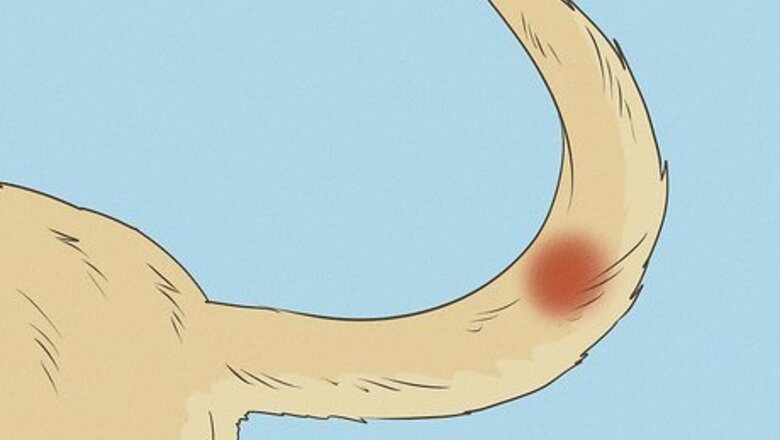
views
X
Research source
[2]
X
Expert Source
Natalie Punt, DVMVeterinarian
Expert Interview. 15 February 2022.
Treat your dog's tail injury by applying ointment and wrapping the tail with gauze and tape. Then, cover the wrapped gauze with cotton and tape the dressing in place.
- Apply antibiotic ointment to any injured portions of the tail, covering the area completely.
- Cut a bandage to size and wrap it all the way around the wound, securing it with tape.
- Cover the bandaged wound with a bit of cotton, then tape it to the tail to prevent further injury.
Wrapping the Tail
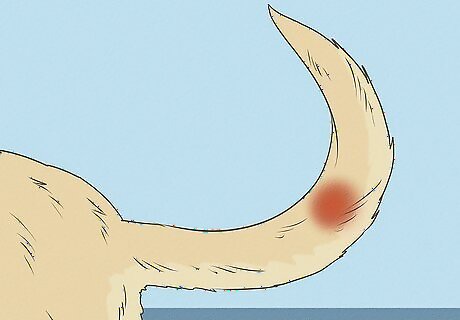
Assess the tail. Before you wrap your dog's tail, look it over to make sure it actually needs a wrap. "Happy tail" will result in obvious blood loss from your dog's tail and you should be able to see where the site of the wound is. Try to contact your veterinarian. They will be able to wrap the tail and check for any other damage. If you are unable to contact your veterinarian, you may have to wrap your dog's tail yourself. Wrapping a dog's tail can help it to heal faster and prevent further injury.
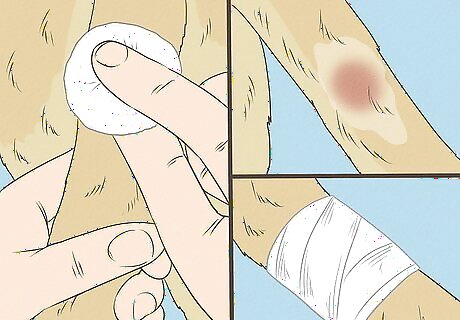
Learn the overview of wrapping your dogs tail. The wrap will be done in three basic stages, applying ointment and gauze, wrapping in cotton for padding, and then taping the bandage to secure everything in place. Ointment goes directly on the wounded area. Clean the area first and then make sure you cover the entire injury with ointment. Gauze and cotton should cover the injury as well. These layers help add protection and keep the ointment where it needs to be. Tape will be applied in two ways. First, apply the tape lengthwise, down the dogs tail and over the gauze and cotton. Then apply rings around those first pieces of tape, starting at the tip and working down the tail.
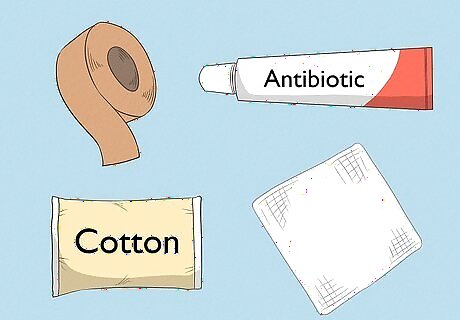
Gather the necessary materials. You will need a few key items to properly wrap your dog's tail. Getting items together before you begin will allow you to work faster when you apply the bandage and minimize discomfort for your dog. Adhesive medical tape with a width of about one inch. Antibiotic ointment (Mycitracin/lidocaine). Neosporin can also work. Cotton. Larger pieces of cotton will be easier to work with. One non-stick gauze pad.
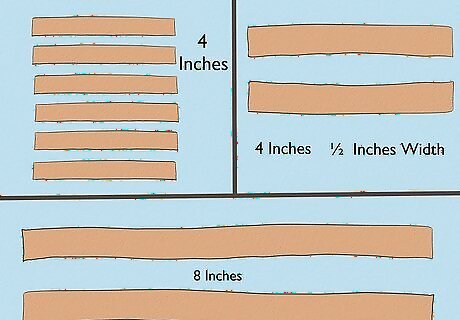
Cut the adhesive tape into smaller pieces. You will want to pre-cut the tape in order to allow you to work quickly. The size of your dog's tail injury will vary, so you may need more or less tape to wrap the tail. However, you can cut about ten strips of the adhesive tape to the following sizes: Two long pieces (eight inches) Six short pieces (four inches) Two half pieces (four inches in length, one half inch in width)
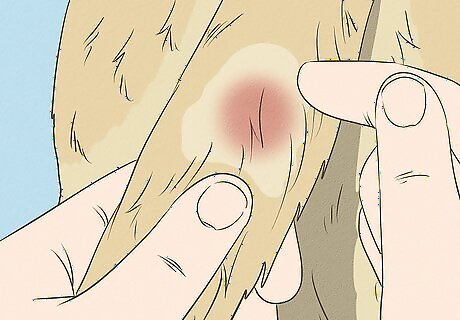
Place the ointment. The ointment will help to prevent infection as well as promote healing. Ointment will need to be reapplied every time you change the bandage. Put ointment on the wound. Make sure you use enough to cover the injured area. You may also want to put some ointment on the gauze bandage as well to ensure that it will come in contact with the wound.
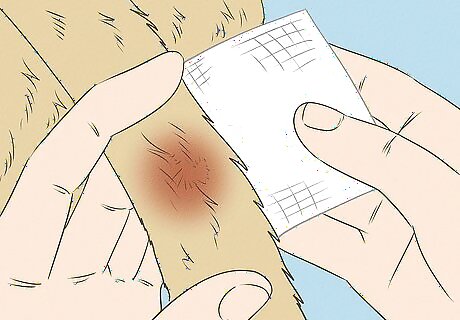
Cut and place a piece of the gauze bandage. Take the gauze bandage and cut out a piece that will be big enough to cover the size of the wound. Gently wrap the bandage around the wound and secure it with the narrow pieces of tape. Don't tape or wrap anything too tightly. Try wrapping the tape down the tail in a spiral. You can also try wrapping the adhesive tape around the tail, at each end of the bandage. Make sure the gauze covers the wound fully.
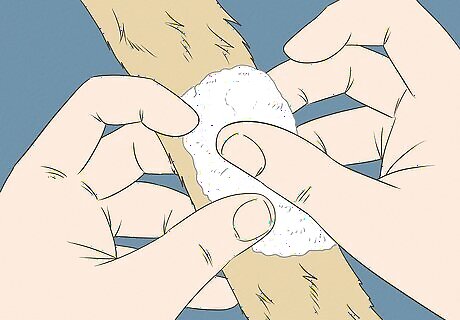
Add the cotton. Take the cotton and place it around the wounded area of the tail. Make sure there is enough cotton to fully cover the area and provide enough padding to keep it from further injury. If you have a large piece of cotton, try wrapping it around the tail just like you would a bandage. Wrap the cotton around the tail entirely at the site of the injury. The cotton should fully cover the gauze and provide padding to the injured area. Carefully compress the cotton, making it conform to the shape of the tail. Be careful not to compress the cotton too forcefully as you may cause further injury to the tail.
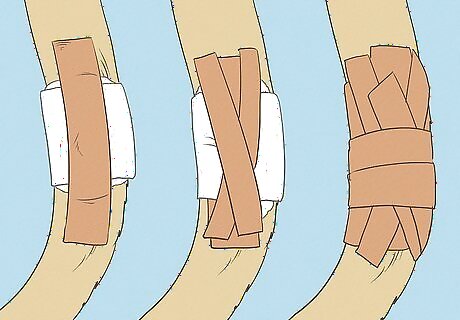
Finish taping the tail. After you have the gauze bandage and cotton in place, you can start to tape them to the tail. The tape you are now adding will form the outside of the bandage as well as help to securely hold the gauze pad in place. These next pieces of tape will run lengthwise, down the dogs tail. Place an eight inch piece of tape lengthwise, parallel to the tail, over the cotton. The tape will start and end on the dog's fur. Place a six inch piece of tape slightly askew of the first eight inch piece. It should start and end in the same places; however, it will be angled off to the right somewhat, covering the first piece only slightly. Add another six inch piece of tape in the same way, expect this time angle it to the left. You should have three pieces of tape now, covering the wound, lengthwise down the dog's tail. They should start and end in the fur, just past the ends of the gauze bandage.
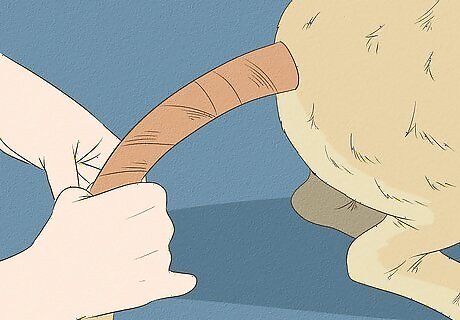
Add more tape. Now that you have the bandage anchored to the tail, it's time to add even more stability and protection. These next few pieces of tape will encircle the tail in rings, similar to the way a mummy is wrapped. Add the last few pieces of tape in the following way: Put a piece of tape around the first three pieces and your dog's tail. Start towards the tip of your dog's tail and work down. Add the next piece of tape, just below this one. It should go all the way around the dog's tail and cover the bandages and tape already affixed. Keep adding tape in this way until you have covered the length of the bandage. Make the last piece of tape overlaps the bandage, sticking to the fur of your dog's tail.
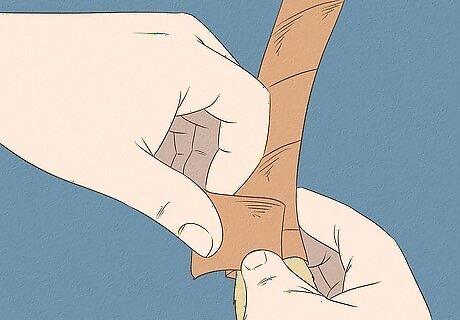
Finish the bandage. Once you have covered the bandage with tape, you are almost done. These last few actions will fully affix the bandage to the tail and keep it secure. Pull a few bunches of hair out from underneath the last tape wrap. Place these bunches of hair flat against the surface of the bandage. Wrap one final piece of tape around these bunches of hair and the tail.
Promoting Healing and Protection

Visit your vet. After you have applied the first bandage, you should visit your veterinarian as soon as you can. You will want to check to see the extent of the damage and how best to treat it. There may be broken bones in the tail that need advanced treatment. Your vet may prescribe certain ointments or have alternative techniques for you to follow. The dog may need stitches if the bleeding too profuse.
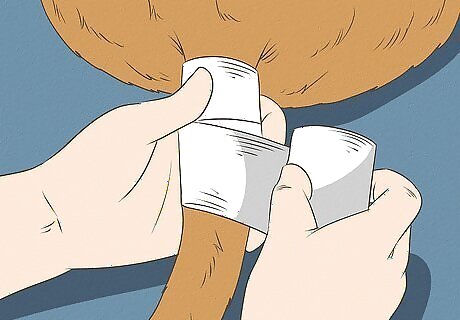
Change the bandage as needed. The bandage will need changing as it will either become soiled, wet, fall off, or be destroyed by the dog chewing it. Apply new bandages as you did before to keep the wound healing, protected, and safe from infection or further damage. Do not leave the bandage in place for more than a day. Wet bandages will trap infections. Most tail problems will heal in two weeks Visit your veterinarian if the wound doesn't seem to be healing.
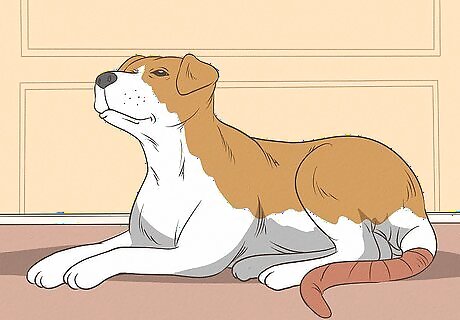
Keep things calm. Happy tail results from your dog either wagging his tail so hard that it bleeds or hitting his tail on a hard surface. If you are able to lower the level of excitement in your dog, you will lower the chances of continued injury to your dog's tail. If your dog gets overly excited when you return home, ignore them, until you get to a larger room that he can wag his tail in without worry of them striking a hard surface. If your dog gets excited about going on a walk, prepare for the walk in a larger room, giving them more space and avoiding any injury to his tail. Try to act calmly around your dog as this can result in calm behavior from them as well. Try using the “sit” command. By having your dog sit, it will reduce the amount of force that he can wag his tail with.
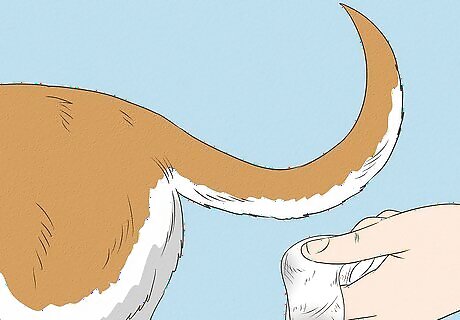
Remove the bandage. If the bandage needs to be on for more than a day, you will have to remove and change the bandage. Leaving a bandage on will increase the chances of infection and won't allow the tail to heal as well as it could. Remove the old bandage by using the following methods: For any areas of the bandage where the fur is stuck to the adhesive, try soaking them in vegetable or olive oil for a few minutes. These oils will help break down the adhesive and allow for easy removal. If your dogs wound is healed, you can also try using shampoo to remove the adhesive and painlessly take the bandage off. For small amounts of fur that are stuck to the bandage, you may simply cut the fur away with a pair of scissors. Exercise caution when cutting the bandage away as it is easy to accidentally cut the dogs tail. If you are not confident doing this, you could take your dog to the groomer. Pulling the bandage off will also pull your dogs hair out and cause it pain. Avoid this method of removal as your dog will come to fear bandages. Do not use any harsh chemicals such as nail polish or rubbing alcohol as these can be harmful to your dog.




















Comments
0 comment